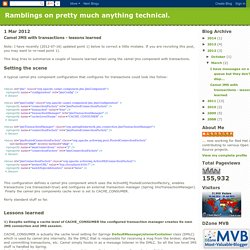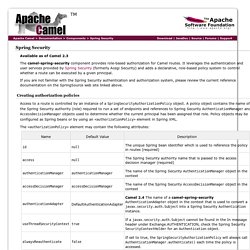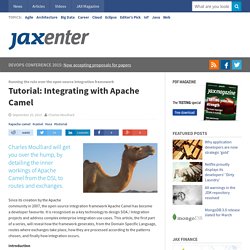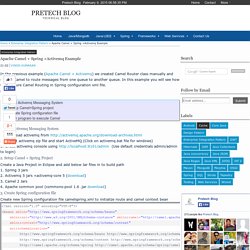

Open Source Integration with Apache Camel and How Fuse IDE Can Help. Take any integration project and you have multiple applications talking over multiple transports on multiple platforms.

As you can imagine, in large enterprise applications this can get complex very fast. Much of the complexity stems from two issues: 1. dealing with the specifics of applications and transports, and 2. coming up with good solutions to integration problems. Making your applications speak transports and APIs is relatively easy on its own. Ignoring the mechanics of how to connect with multiple transports and APIs, we can focus on the high level design of how applications interact. Apache Camel was created with the intention of addressing these two issues. What is Camel? Apache Camel is an open source Java framework that focuses on making integration easier and more accessible to developers. . • concrete implementations of all the widely used EIPs • connectivity to a great variety of transports and APIs Figure 1 shows how these three items actually map to Camel concepts. . • Java DSL. Camel JMS with transactions - lessons learned. Note: I have recently (2012-07-16) updated point 1) below to correct a little mistake.

If you are revisiting this post, you may want to re-read point 1). This blog tries to summarize a couple of lessons learned when using the camel-jms component with transactions. Setting the scene A typical camel-jms component configuration that configures for transactions could look like follow: This configuration defines a camel-jms component which uses the ActiveMQ PooledConnectionFactory, enables transactions (via transacted=true) and configures an external transaction manager (Spring JmsTransactionManager). Fairly standard stuff so far. Lessons learned 1) Despite setting a cache level of CACHE_CONSUMER the configured transaction manager creates its own JMS connection and JMS session. CACHE_CONSUMER is actually the cache level setting for Springs DefaultMessageListenerContainer class (DMLC) which is used by camel-jms internally.
The low level JMS code reads as follows throws JMSException { try { Ramblings on pretty much anything technical.: Camel JMS with transactions - lessons learned.
Camel Headers/Security. Spring Security. Available as of Camel 2.3 The camel-spring-security component provides role-based authorization for Camel routes.

It leverages the authentication and user services provided by Spring Security (formerly Acegi Security) and adds a declarative, role-based policy system to control whether a route can be executed by a given principal. If you are not familiar with the Spring Security authentication and authorization system, please review the current reference documentation on the SpringSource web site linked above. Creating authorization policies Access to a route is controlled by an instance of a SpringSecurityAuthorizationPolicy object. The <authorizationPolicy> element may contain the following attributes: Tutorial: Integrating with Apache Camel. Since its creation by the Apache community in 2007, the open source integration framework Apache Camel has become a developer favourite.

It is recognised as a key technology to design SOA / Integration projects and address complex enterprise integration use cases. This article, the first part of a series, will reveal how the framework generates, from the Domain Specific Language, routes where exchanges take place, how they are processed according to the patterns chosen, and finally how integration occurs.
Introduction From a general point of view, designing an integration architecture is not such an obvious task even if the technology and the frameworks you want to use are relatively easy to understand and implement. The difficulties lie in the volume of messages, transformations to apply, synchronicity or asynchronocity of exchanges, processes running sequentially or in parallel, and of course the monitoring of such projects running in multiple JVMs. Figure 1: SOA EIP design icons. Apache Camel + Spring +Activemq Example - Pretech Blog. In the previous example (Apache Camel + Activemq) we created Camel Router class manually and started Camel to route messages from one queue to another queue.

In this example you will see how to configure Camel Routing in Spring configuration xml file. Goals 1. Start Activemq Messaging System2. Setup Camel+Spring project3. 1. 2. Create a Java Project in Eclipse and add below Jar files in to build path1. Enterprise Integration Patterns. Spring - Camel lookup RemoteConnectionFactory on Wildfly. Bsides-JonAnstey.pdf.